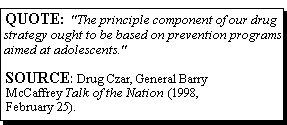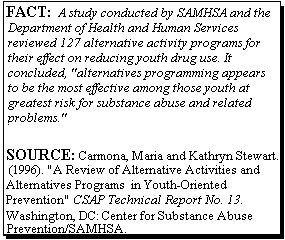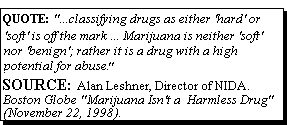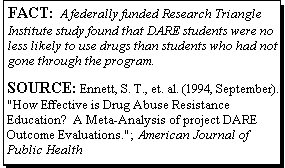
OBJECTIVE: REDUCE DRUG ABUSE AND USE AMONG YOUTH AND YOUNG ADULTS
 Rationale: Our nation should focus its efforts on fact-based education as
well as programs to dissuade adolescents from the use of alcohol, tobacco and illegal drugs.
Rationale: Our nation should focus its efforts on fact-based education as
well as programs to dissuade adolescents from the use of alcohol, tobacco and illegal drugs.
Adolescent drug use has been rising steadily since 1991, which is the longest sustained increase in adolescent drug use since the Monitoring the Future Survey began. After the release of the 1998 Monitoring the Future Survey,
17 the ONDCP issued a surprising press release which stated “Second Straight Year of No Significant Increases, Many Categories of Youth Drug Use Fall Significantly.” General McCaffrey is quoted as saying, “The 1998 Study shows that we have turned the tide of youth drug use.”18 Unfortunately, a review of the actual survey data shows a sharply different result.
Survey data indicate that modest declines in the use of the traditionally popular drug
marijuana comprised the major portion of lowered numbers. This decline masked a continuing
rise in hard drug use by our youth. For instance, the percentage of high school seniors
reporting lifetime marijuana use dropped by 0.5%, but the percentage of high school seniors
reporting lifetime crack use increased by 0.5%. Twice as many students reported
using heroin by the 8th grade in 1998 as was reported in 1991. Nearly three times as many
students reported using crack by the 8th grade for the same time period. Exchanging
marijuana use for crack and heroin is clearly not the type of trade-off that most parents
would like to see. The ONDCP's failure to mention any of these significant issues in their
official press statement cheats parents, educators and journalists out of their ability to
understand the dimensions of adolescent drug use.

Figure 9 Adolescent use of crack and heroin. Source: 1998 Monitoring the Future Survey, Institute for Social Research, University of Michigan.
Recommendation 1: TRIPLE the current National Drug Control Strategy budget share for reducing youth and young adult drug use.
 Despite claims that the War on Drugs is being fought to save future generations of children
from being hooked on drugs, and despite Drug Czar Barry McCaffrey's promise to focus his
office's efforts on youth drug use prevention, the ONDCP is budgeting less than 12% of
the $100 billion it is planning to allocate between 1998 and 2003 for reducing youth drug
use.
Despite claims that the War on Drugs is being fought to save future generations of children
from being hooked on drugs, and despite Drug Czar Barry McCaffrey's promise to focus his
office's efforts on youth drug use prevention, the ONDCP is budgeting less than 12% of
the $100 billion it is planning to allocate between 1998 and 2003 for reducing youth drug
use.
Recommendation 2: Focus funding and efforts on strategies that have documented success in reducing youth drug use.
 According to SAMHSA, “alcohol and drug use tends to be a chosen activity engaged in
during unstructured and unsupervised
time.”
According to SAMHSA, “alcohol and drug use tends to be a chosen activity engaged in
during unstructured and unsupervised
time.”
Researchers have noted that “adolescence is a period in which youth reject conventionality and traditional authority figures in an effort to establish their own independence… drug use may be a 'default' activity engaged in when youth have few or no opportunities to assert their independence in a constructive manner.”
22 Moreover, twice as many youths from low-income families are unsupervised for more than three hours per day than youths from high-income families.23 In an independent study of the Big Brother/Big Sister Program, researchers found that “Little Brothers and Little Sisters were 46% less likely to start using illegal drugs, and 27% less likely to start drinking.” Little Brothers and Little Sisters also did better in school, had better attendance records, and felt slightly better about how they would perform in school.24 Constructive activities and mentoring programs provide a strong environment for youths and young adults to reject all forms of drug use and provide benefits across a wide array of indicators, such as school performance and self-esteem. These kinds of strategies should be central to our efforts to reduce youth and young adult drug use because they actually work.Recommendation 3: Use facts, not scare-tactics to educate youth.
 Education is a key component of any plan to change self-destructive behavior. In order for
it to be effective and not undermine its purpose, education must be completely factual and
rational. By relying on scare-tactics and unfounded assertions, the current drug policy has
failed to achieve its purpose. Nowhere can this be more clearly seen than where exaggerated
claims about marijuana lead youth and young adults to disbelieve information about harder
drugs as
well.
Education is a key component of any plan to change self-destructive behavior. In order for
it to be effective and not undermine its purpose, education must be completely factual and
rational. By relying on scare-tactics and unfounded assertions, the current drug policy has
failed to achieve its purpose. Nowhere can this be more clearly seen than where exaggerated
claims about marijuana lead youth and young adults to disbelieve information about harder
drugs as
well.
Recommendation 4: Redirect DARE funding into more productive and effective programs.
 Support for the DARE (Drug Abuse Resistance
Education)
Support for the DARE (Drug Abuse Resistance
Education)
A key aspect of DARE's failure to be effective stems from the program's basic premise – the idea that police are appropriate teachers of health information. Police do not teach children about sex education, hygiene or dental care, so why are they teaching children about drugs? It sends the wrong message that drugs are a law enforcement issue, rather than a public health issue. More importantly, a police officer may intimidate adolescents who have experimented with drugs from asking lifesaving questions out of fear that they will get into trouble.
In spite of DARE's documented lack of success and its inherent weaknesses, the federal drug education budget provides a 'set aside' for DARE, ensuring that it continues to squander the few prevention dollars this country spends on adolescent drug education. This a failure on the part of our government to protect children from the dangers of drug use and drug abuse. At the very least, DARE should be required to compete with other drug education programs and prove that it can be effective.
Furthermore, since federally sponsored studies indicate that nearly 50% of all students try an illegal drug before they graduate from high school, and 85% of students try alcohol,
28 the goal of drug education should be broadened to include reducing the harms related to alcohol and other drug use, as well as preventing adolescent alcohol and other drug use from the outset.Recommendation 5: Be responsible with the provision of anti-drug messages.
The ONDCP's newly launched $2 billion advertising campaign to make children aware of the dangers of drug use has been approached in an unscientific and irresponsible way. There is no evidence that advertising is likely to prevent drug abuse, and in fact highlighting drug use may have the reverse effect. In the 1960s, media stories which promoted the dangers of using glue to intoxicate oneself only served to inform children that the common substance could produce a high, and “to popularize rather than to discourage the practice.” Prior to 1959, glue-sniffing was virtually unknown, but with its publicity, the number of high school students who reported trying it at least once rose to about 1 in 20 by the mid to late 1960s.
30Today, the ONDCP is running a series of advertisements on household inhalants which airs during children's cartoons and while parents are away at work. Just as with the glue-sniffing stories of the 1960s, it is very likely that most young people do not know that inhaling the vapors of everyday household products can produce a high, until they view the advertisements on television. Sending this information into the homes of children without parental consent is irresponsible and has enormous potential for tragedy as children may decide to experiment with the chemicals found under every kitchen sink. According to David Kiley, the Senior Editor of the advertising industry's Brandweek, the research relied upon by the ONDCP, “hardly stands up to the slightest breeze of inquiry. In some cases the validity of key parts of the research is even refuted by the people responsible for it.”
31
17 The Monitoring the Future Survey is an annual survey of drug
use by 8th, 10th, and 12th grade students.
18 ONDCP, "1998 Monitoring the Future Study: Tide of Youth Drug Use
Turns" December 18, 1998 (press release).
19 McCaffrey, Barry R. (1998). The National Drug Control Strategy,
1998: A Ten Year Plan. Washington, DC: Office of National Drug Control
Policy, p. 58.
20 Carmona, Maria and Kathryn Stewart. (1996). "A Review of Alternative
Activities and Alternatives Programs in Youth-Oriented Prevention" CSAP
Technical Report No. 13. Washington, DC: Center for Substance Abuse
Prevention/ Substance Abuse and Mental Health Administration/ Department of
Health and Human Services, p. 3.
21 Federal Register, Volume 58, Number 60, March 31,
1993.
22 Carmona and Stewart, p. 5.
23 Carmona and Stewart, p. 5.
24 Tierney, Joseph P., Jean Baldwin Grossman, and Nancy L. Resch. (1995
November). Making a Difference: An Impact Study of Big Brothers/Big
Sisters. P. 49. Philadelphia, PA: Public/Private Ventures.
25 Perhaps the main justification for a "zero-tolerance" policy towards
marijuana, even to prevent blindness in glaucoma patients or to ease nausea in
cancer patients, is the belief that marijuana is a "gateway" drug which leads
young people to seek ever more powerful drugs like cocaine and heroin. Some
research institutions have tried to prove the existence of the gateway effect,
but none have succeeded. The National Center on Addiction and Substance Abuse
(CASA) is the leading proponent of the theory today, but even it has had to
acknowledge that "what is lacking is the basic scientific and clinical research
required to establish causality." [Merrill, Jeffrey C. and Kimberly S. Fox.
(1994). Cigarettes, Alcohol, Marijuana: Gateways to Illicit Drug Use,
"Implications for Future Action." New York, NY: CASA.] CASA's researchers have
also had to acknowledge that "the majority of gateway drug users never move on
to other drugs..." [Merrill & Fox, 1994]. Within its report, CASA
acknowledges that the statistical correlation of cocaine and marijuana use
"does not necessarily prove that a causal relationship exists." [Merrill &
Fox, 1994]. And, although CASA's researchers note that "the majority of
marijuana users never use any other illegal drug," CASA refuses to acknowledge
that "for the large majority of people, marijuana is a terminus rather
than a gateway drug." [Zimmer and Morgan, p. 32.]
26 DARE was created by former Los Angeles Police Chief, Daryl Gates.
The program employs uniformed police officers to teach drug education to public
school children.
27 Ennett, S. T., et. al. (1994, September). "How Effective is Drug
Abuse Resistance Education? A Meta-analysis of project DARE Outcome
Evaluations." American Journal of Public Health.
28 Half the high school students in the United States will try illegal
drugs before they graduate. Johnston, L., Bachman, J. & O'Malley, P.
(1996). National survey results from the monitoring the future study,
HHS, National Institute on Drug Abuse.
29 Brecher, Edward M. The Consumers' Union Report on Licit and
Illicit Drugs. "How to Launch a Nationwide Drug Menace." Ch. 44. (1972).
Little Brown and Company.
30 Ibid.
31 Kiley, David. (1998, April 27). "Blind Support for Anti-Drug Ads?
Just Say No." Brandweek.